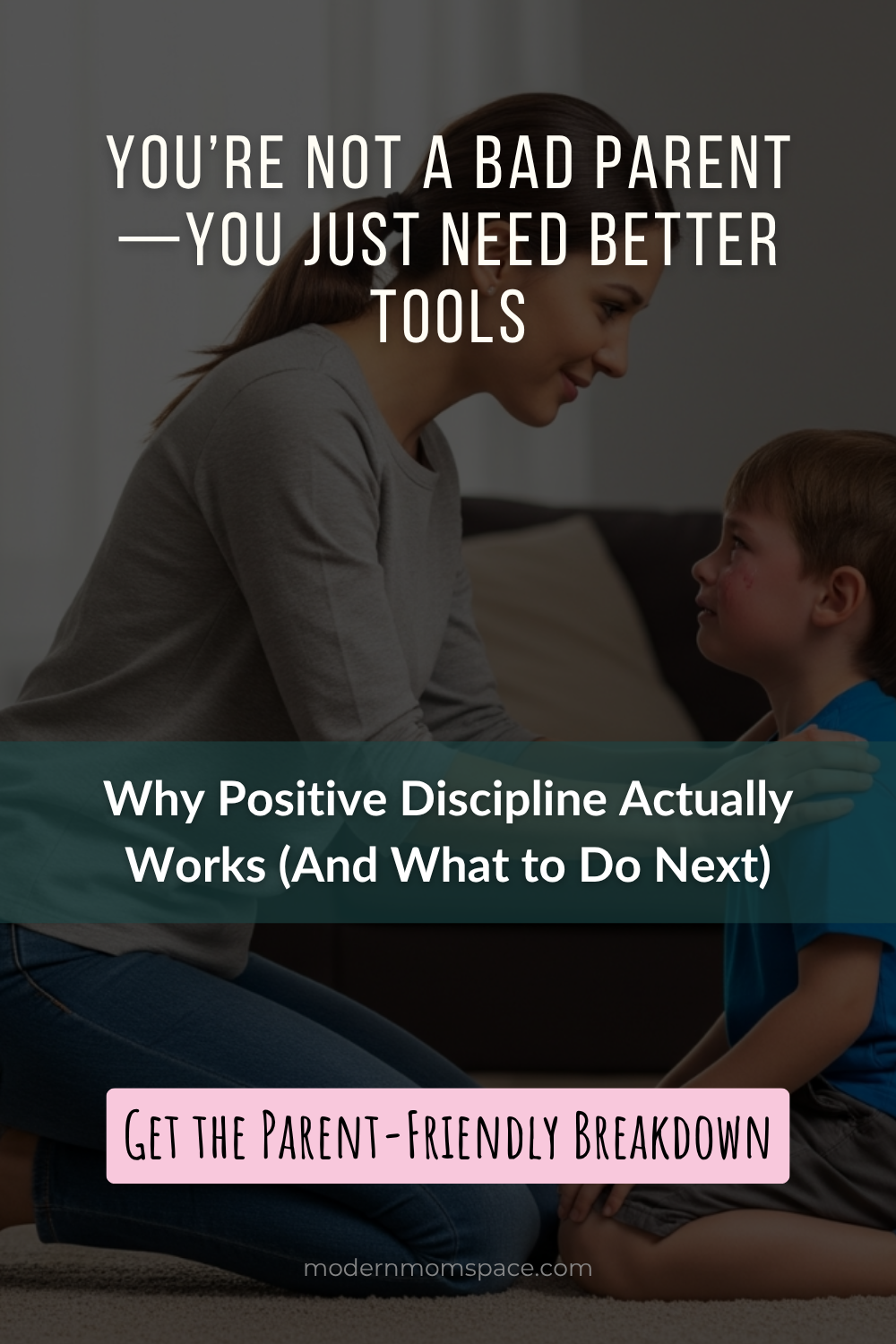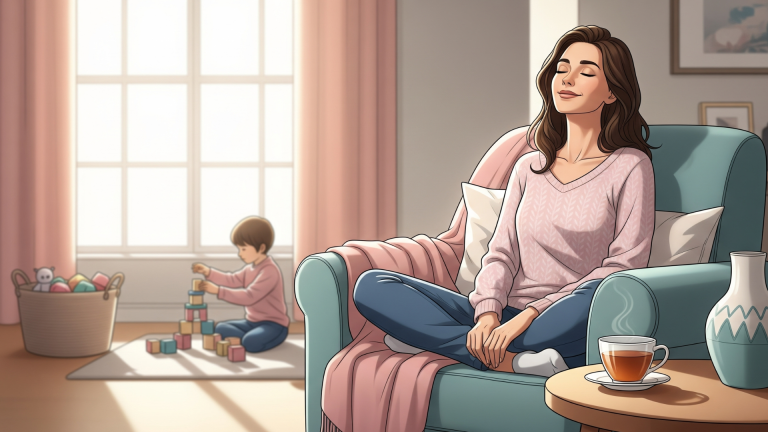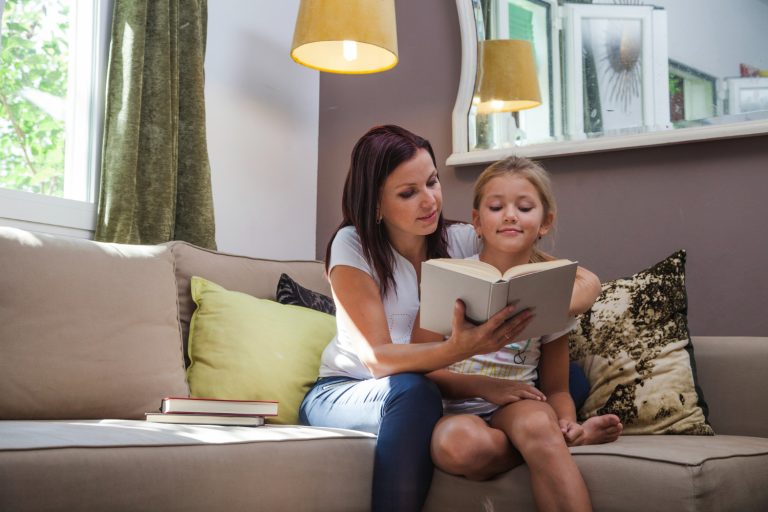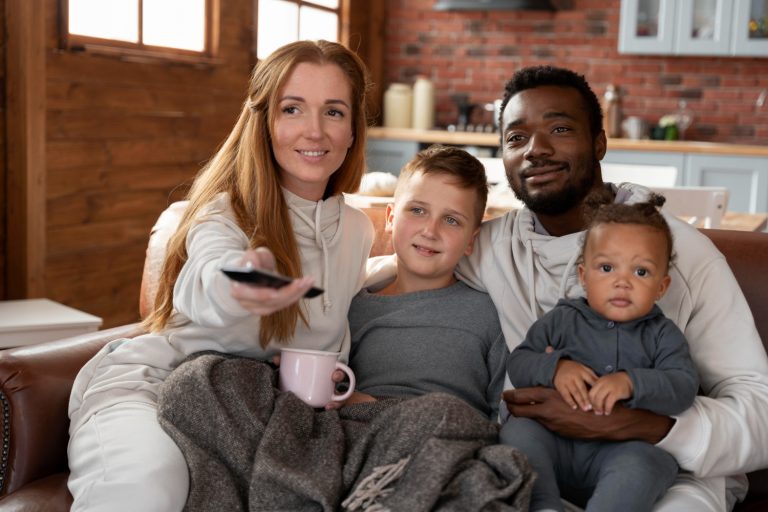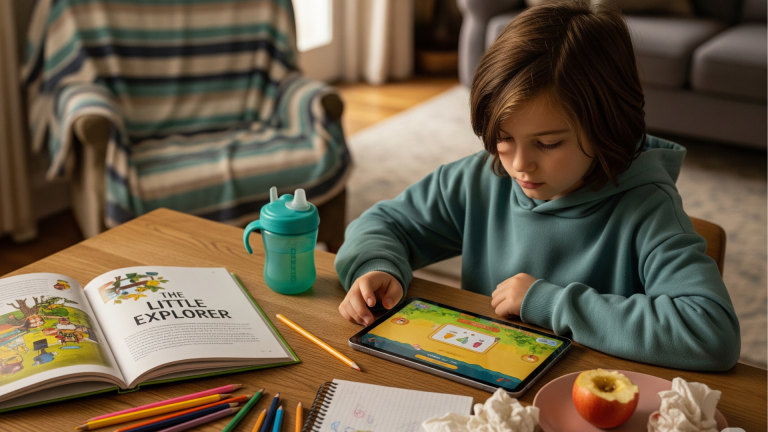What Is Positive Discipline? (And Why This Proven Method Works Better Than Punishment)
Discipline Without Damage?
“If I don’t punish them, they’ll never learn.”
That thought creeps in during the heat of the moment—when your kid’s talking back, ignoring instructions, or melting down in the grocery aisle. You want to raise a kind, respectful, emotionally strong human. But some days it feels like your only options are yelling, threatening a consequence, or just giving up and letting them “win.”
Here’s the thing no one tells you when you become a parent:
You’re expected to manage behavior without actually being taught how to do it.
That’s where Positive Discipline comes in.
It’s not about ignoring bad behavior. It’s not about negotiating with a toddler over bedtime. And it’s definitely not about raising your voice until they finally listen.
Positive Discipline is about teaching, not punishing. It’s how you raise kids with boundaries and respect—without yelling, threats, or power struggles. It’s not new. But most of us were never raised with it. And that’s why it feels unfamiliar.
“So here’s the myth: You either yell… or you give in. But there’s a third option—and it works better.”
This article is your no-fluff guide to what is Positive Discipline, what it isn’t, and why it works so well—even for strong-willed, high-energy kids.
Common Myths About Positive Discipline
Let’s be honest: the name doesn’t help.
Positive Discipline? Sounds like parenting with a vision board and a scented candle.
But this approach isn’t soft. It’s structured. And it’s backed by research, not trends.
Still, a lot of parents—especially those raised on time-outs, spankings, or “because I said so”—bring baggage to the term. So let’s clear up what Positive Discipline is not before we go any further.
Myth 1: “It just lets kids get away with bad behavior.”
Nope. Positive Discipline isn’t about ignoring misbehavior or pretending everything’s fine. In fact, it’s the opposite: it calls for consistency, clear limits, and follow-through. The difference is how you enforce those limits.
Punishment tries to control the behavior through fear or pain. Positive Discipline teaches the child why the behavior matters, and what to do instead. It’s slower in the moment, but it builds real behavioral change that sticks.
Myth 2: “It won’t work on my strong-willed kid.”
Strong-willed kids actually need Positive Discipline the most—because it gives them structure without breaking their spirit. These are the kids who push back against control. Harsh discipline often turns into power struggles or emotional shutdown.
With Positive Discipline, you’re saying: “I see your need for autonomy. I’ll work with it—not against it. But I’m still in charge.” That combination of respect + firmness is what gets through to them.
Myth 3: “It’s too soft—it won’t prepare them for the real world.”
This one’s rooted in fear. And it’s understandable—no one wants to raise a kid who crumbles at the first sign of challenge. But here’s the reality:
The “real world” doesn’t respond well to people who’ve been conditioned to obey out of fear.
It rewards people who can manage themselves, think critically, and take responsibility.
That’s exactly what Positive Discipline builds. Emotional regulation. Conflict resolution. Accountability. The stuff that actually prepares a child to function without constant external control.
So What Is Positive Discipline, Really?
“It’s not about being nice all the time. It’s about being clear, calm, and in charge—without being a jerk.”
Positive Discipline is a parenting approach that combines kindness and firmness at the same time. It’s built on the idea that kids do better when they feel better—when they feel connected, capable, and respected.
This isn’t just a parenting trend. It’s based on solid psychological roots—specifically the work of Alfred Adler and Rudolf Dreikurs, and popularized by Dr. Jane Nelsen. The core idea? Kids behave well when they feel a sense of belonging and significance. When they act out, it’s often because they feel powerless, disconnected, or unsure of their place in the family system.
Positive Discipline doesn’t excuse bad behavior. It gives kids tools to handle tough moments better—and teaches them what’s expected in a way that actually builds long-term skills.
The Short Definition:
Positive Discipline teaches children how to behave responsibly through respect, empathy, and structure—without yelling, spanking, or shaming.
So What Makes It Different?
Let’s break it down:
| Traditional Discipline | Positive Discipline |
|---|---|
| “Do it because I said so.” | “Let’s figure out what went wrong—and fix it.” |
| Focus on obedience through fear | Focus on internal motivation and understanding |
| Consequences as punishment | Consequences as learning opportunities |
| Parent in full control | Parent as calm leader; child involved in solutions |
| Temporary compliance | Long-term self-regulation and cooperation |
Example: Same Behavior, Two Very Different Responses
Scenario: Your 5-year-old hits their sibling.
This approach isn’t about being soft. It’s about being effective. You’re teaching emotional intelligence, accountability, and conflict resolution—skills they’ll use long after they grow out of the timeout stage.
Why Positive Discipline Works (According to Research)
Most parenting advice is based on “what worked for me” stories. But Positive Discipline isn’t just opinion—it’s backed by real research from schools, psychologists, and parenting studies around the world.
Let’s break it down.
Study After Study Shows: This Stuff Actually Works
Preschoolers: More Cooperation, Less Meltdowns
A randomized controlled trial tested an 8-session online Positive Discipline course with parents of kids aged 3 to 6. The results?
Source: PubMed, 2023
In the Classroom: Fewer Disruptions, Stronger Relationships
One international school in Cairo adopted Positive Discipline across all grades. After six years, teachers reported:
This wasn’t about bribing kids or removing rules. It was about shifting from control to collaboration.
Parents Feel More in Control (Not Less)
A group study with Chinese mothers showed something that surprises a lot of skeptics:
So no, it doesn’t mean “letting your kid walk all over you.” It means knowing what to say and how to say it—without the emotional hangover.
Source: PubMed, 2024
“But what about strong-willed kids? Teens? Real-life chaos?”
Yep. Still works.
For Older Kids and Tweens: Less Drama, More Problem-Solving
Positive parenting approaches (which include Positive Discipline) consistently show better outcomes in kids aged 6–12:
Especially for kids who’ve been through trauma or instability, the respectful, structured approach of Positive Discipline provides the safety and consistency they need to change behavior for good.
Meta-analysis: SpringerLink, 2022
For Parents: Less Burnout, More Connection
Programs based on Positive Discipline report:
The Takeaway:
Positive Discipline isn’t just “nicer.” It’s smarter—because it works with how kids actually learn and grow. It helps them regulate their emotions, take responsibility, and do better… without fear-based compliance.
The Core Principles of Positive Discipline
If you’ve made it this far, you get that Positive Discipline isn’t permissive. It’s not just about “gentle parenting” or being endlessly patient. It’s a system—a grounded, practical one—with clear principles.
Here are the five core ideas that make it work.
“This isn’t about being your child’s best friend. It’s about being their steady leader—with compassion and a spine”.
1. Belonging and Significance
Kids need to feel like they matter. That they’re connected to the people around them, and that their presence counts.
When kids feel disconnected, they act out—not because they’re bad, but because they’re trying to meet a need: attention, power, control, comfort.
What this looks like:
When a child feels seen, they stop screaming for attention.
2. Kind and Firm at the Same Time
This is the heart of Positive Discipline—and the hardest part for most parents to master.
It’s not a power trip. It’s not about control. It’s about leading with clarity and calm.
Example:
“I know you’re frustrated. And it’s still time to clean up.”
3. Long-Term Effectiveness
Punishment might work in the short term—but it doesn’t teach anything useful. Kids might stop the behavior to avoid pain or fear, but they won’t understand the why behind the rule.
Positive Discipline asks: What do I want my child to learn from this moment?
That’s where the real shift happens—from control to teaching.
Compare:
4. Teaches Social and Life Skills
Kids need more than obedience. They need tools. Self-regulation. Conflict resolution. Empathy. Problem solving. The ability to sit with uncomfortable emotions and choose something better.
Positive Discipline builds those skills in real time—through conversations, modeling, and natural consequences.
What this looks like:
5. Encourages Capability
Kids want to feel useful and competent. When you let them take ownership—over their routines, their emotions, their solutions—they rise to it.
Positive Discipline is full of practical tools to build that sense of “I can do this.”
Tools include:
Quick Recap:
| Principle | What It Builds |
|---|---|
| Belonging & Significance | Connection, motivation |
| Kind and Firm | Respectful authority |
| Long-Term Effectiveness | Real behavioral change |
| Social & Life Skills | Emotional intelligence, responsibility |
| Encouraged Capability | Confidence, independence |
Positive Discipline Examples in Real Life
It’s easy to nod along with “kind and firm” in theory. But what happens when your kid is losing it in Target, screams “you’re the worst parent ever,” or flat-out refuses to get in the car?
Let’s talk real life.
“This isn’t parenting on a calm Sunday morning. This is parenting in traffic, at bedtime, and five minutes before a Zoom meeting”.
Here’s how Positive Discipline plays out in common situations.
Scenario 1: Whining for Juice (Again)
Old Pattern:
“Stop whining! I already said no. If you keep going, no iPad.”
Positive Discipline Approach:
“You really want juice, and I said no. I know it’s hard to hear no. When you’re ready to talk without whining, I’ll listen.”
Why it works:
You’re acknowledging the emotion, holding the boundary, and giving them a way to regulate—not just obey.
Scenario 2: Hitting a Sibling
Old Pattern:
“That’s it. Go to your room! No screen time all day.”
Positive Discipline Approach:
“I won’t let you hurt your sister. You must be really upset. We’ll take a break and talk about what happened.”
Later:
“What could you do next time instead of hitting? Let’s think of a plan together.”
Why it works:
You stop the harm and teach self-control. You also keep the door open for repair, not shame.
Scenario 3: Refusing to Get Ready for Bed
Old Pattern:
“If you don’t brush your teeth now, no story tonight!”
Positive Discipline Approach:
“We’re getting close to bedtime. You can choose: brush teeth now and have a story, or skip the story if it’s too late.”
Why it works:
You’re not punishing—you’re handing over age-appropriate control within a boundary.
Scenario 4: Ignoring You When It’s Time to Stop Screens
Old Pattern:
“Turn it off now! I told you five times. You never listen.”
Positive Discipline Approach:
“We agreed screen time ends at 5. I see it’s past 5. What’s our next step?”
Why it works:
Instead of power struggle or threats, you bring the child back to shared expectations and invite responsibility.
Want a full breakdown of how to set tech rules that actually stick—without yelling or screen-time battles?
Read: Digital Boundaries for Kids: How to Set Limits That Stick
Scenario 5: Backtalk or “You’re So Mean!”
Old Pattern:
“You don’t talk to me like that! Go to your room!”
Positive Discipline Approach:
“You sound really mad. I want to hear what you’re feeling—but not like that. Try again when you’re ready to talk respectfully.”
Why it works:
It reinforces respectful communication without shutting them down or escalating.
These aren’t magic words. Your kid might still whine, yell, or slam a door. That’s normal. The difference is you’re not adding fuel to the fire. You’re modeling calm, holding firm, and guiding them toward better tools—again and again.
That’s how change happens.
What It’s Not: Avoiding the Traps
By now you get it—Positive Discipline isn’t permissive. But a lot of parents try to “go gentle” and accidentally swing too far in the other direction. No limits. Too many choices. Apologizing for every boundary. And then they wonder why their kid is melting down, not listening, or turning into a tiny tyrant.
Let’s set the record straight.
“Respecting your child doesn’t mean fearing them.”
Here are the most common traps people fall into when trying to use Positive Discipline—and how to avoid them.
It’s not letting your kid run the show.
Positive Discipline isn’t “child-led” in the sense of no leadership. You’re still the adult. You still set the structure, make the final call, and enforce limits.
You’re validating feelings and holding the line. That’s the combo.
It’s not avoiding conflict to “keep the peace.”
If you’re constantly giving in to prevent a meltdown, you’re not being kind—you’re being unclear. Kids need structure to feel safe. When everything becomes negotiable, they become anxious or controlling.
Positive Discipline says: Kindness doesn’t mean giving in. Firmness doesn’t mean being cold.
It’s not replacing punishment with endless talking.
Talking at a kid for five minutes straight after a problem behavior isn’t teaching—it’s lecturing. And they’ve tuned you out by minute two.
Keep it simple. Clear message. Empathy. Natural or logical consequence. Then move on.
No lectures. No guilt trips. Just steady leadership.
It’s not being “nice” to avoid feeling like the bad guy.
You’re not doing your child any favors by being overly “nice” if it means avoiding accountability. Kids don’t need a best friend. They need a steady adult who can handle their big feelings without losing their own grip.
Positive Discipline is about teaching, not pleasing. You’re not raising a fan club. You’re raising a human.
How to Tell If You’re Doing It Right
Ask yourself after any tough moment:
If yes—you’re on the right track.
Why Positive Discipline Matters for Today’s Parents
Let’s be real: modern parenting is nothing like the world we grew up in.
We’re raising kids in a time of:
And many of us were raised with outdated discipline tools—shame, spanking, threats, silence—that might’ve “worked” on the surface, but left lasting baggage underneath.
“We were told to stop crying. Now we’re trying to teach our kids to feel their feelings. No wonder it’s hard.”
Positive Discipline matters right now because it gives us a roadmap that fits the world we actually live in—not the one we grew up in.
1. Today’s Kids Don’t Respond to Fear
That’s not weakness. It’s evolution.
Kids today are exposed to more information, more complexity, and more emotional stimulation than any generation before. What they need isn’t more control. It’s stronger connection and smarter structure.
Positive Discipline meets them where they are. It teaches why behavior matters. It builds self-regulation. It strengthens the bond—not by giving in, but by staying calm and consistent.
2. Today’s Parents Don’t Want to Repeat the Cycle
You’ve probably said it (or thought it):
“I don’t want to yell like my mom.”
“I want to be better than what I grew up with.”
“But I also don’t want to raise a brat.”
That’s the tightrope most modern parents are walking—trying to break old patterns without swinging so far that they lose control.
Positive Discipline helps you walk that line with tools. Not guilt. Not guesswork.
Curious how to parent in a tech-heavy world without losing your values—or your sanity?
Read: Raising Kids in the Digital Age: What Actually Works
3. It Gives You Language You Can Use Under Pressure
Because let’s face it: when your kid is screaming and you’re running on four hours of sleep, it’s hard to “be gentle” or “stay regulated.” You don’t need idealism. You need a default script that kicks in when your brain goes blank.
Positive Discipline is that script.
It’s how you show up with authority and empathy—even when you’re tired, triggered, and two seconds from snapping.
4. It Builds the Skills That Actually Matter
In a world full of devices, distractions, and emotional burnout, our kids don’t need to be controlled—they need to be equipped.
Positive Discipline builds:
That’s the stuff that carries them through school, friendship drama, teen years, and adult life.
4. And Honestly? It Makes Parenting Feel Less Like a Battle
No one becomes a parent thinking, “I can’t wait to argue with my kid about bedtime for the next 10 years.”
You want peace. Not perfection—but less drama. More cooperation. More connection. Less second-guessing.
That’s why this matters.
Key Takeaways + What to Do Next
If you’ve ever walked away from a meltdown thinking, “I didn’t handle that how I wanted to”—you’re not alone.
Parenting is hard. But it doesn’t have to feel like a constant power struggle. And you don’t have to choose between yelling and giving in.
Positive Discipline gives you a third path.
Quick Recap
Here’s what to remember:
Want to Try It?
Start small. You don’t need a parenting makeover. You just need new tools to reach for in hard moments.
Here’s what you can do next:
Final Thought:
You’re not “too soft” for using Positive Discipline.
You’re just parenting with clarity—and a hell of a lot more emotional intelligence than the generation before you.
And that’s exactly what your kid needs.
Save it. Share it. Send it.
Found this guide helpful?
Save it for the next meltdown.
Share it in your parenting group chat.
Or send it to the mom who’s stuck between “I don’t want to yell” and “Nothing’s working.”This isn’t just about behavior—it’s about building trust, boundaries, and emotional strength.
Let’s help each other parent with clarity and confidence.


